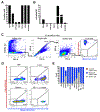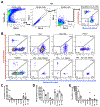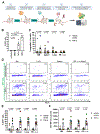μ-Lat: A mouse model to evaluate human immunodeficiency virus eradication strategies
- PMID: 32901981
- PMCID: PMC8787083
- DOI: 10.1096/fj.202001612RR
μ-Lat: A mouse model to evaluate human immunodeficiency virus eradication strategies
Abstract
A critical barrier to the development of a human immunodeficiency virus (HIV) cure is the lack of a scalable animal model that enables robust evaluation of eradication approaches prior to testing in humans. We established a humanized mouse model of latent HIV infection by transplanting "J-Lat" cells, Jurkat cells harboring a latent HIV provirus encoding an enhanced green fluorescent protein (GFP) reporter, into irradiated adult NOD.Cg-Prkdcscid Il2rgtm1Wjl /SzJ (NSG) mice. J-Lat cells exhibited successful engraftment in several tissues including spleen, bone barrow, peripheral blood, and lung, in line with the diverse natural tissue tropism of HIV. Administration of tumor necrosis factor (TNF)-α, an established HIV latency reversal agent, significantly induced GFP expression in engrafted cells across tissues, reflecting viral reactivation. These data suggest that our murine latency ("μ-Lat") model enables efficient determination of how effectively viral eradication agents, including latency reversal agents, penetrate, and function in diverse anatomical sites harboring HIV in vivo.
Keywords: HIV; HIV latency; antiviral gene therapy; humanized mouse; latency reversal; shock and kill.
© 2020 Federation of American Societies for Experimental Biology.
Conflict of interest statement
Conflict of interest statement
The authors have declared that no conflict of interest exists.
Figures






References
-
- Wong JK, Hezareh M, Günthard HF, Havlir DV, Ignacio CC, Spina CA, et al. Recovery of replication-competent HIV despite prolonged suppression of plasma viremia. Science (80- ) [Internet]. 1997. Nov 14 [cited 2019 Nov 15];278(5341):1291–5. Available from: http://www.ncbi.nlm.nih.gov/pubmed/9360926 - PubMed
-
- Piot P, Bartos M, Ghys PD, Walker N, Schwartländer B. The global impact of HIV/AIDS. Nature [Internet]. 2001. Apr 19 [cited 2019 Nov 15];410(6831):968–73. Available from: http://www.nature.com/articles/35073639 - PubMed
-
- Pitman MC, Lau JSY, McMahon JH, Lewin SR. Barriers and strategies to achieve a cure for HIV. Lancet HIV [Internet]. 2018. Jun [cited 2019 Nov 15];5(6):e317–28. Available from: https://linkinghub.elsevier.com/retrieve/pii/S0031938416312148 - PMC - PubMed
-
- Schwarzer Gramatica, Greene. Reduce and Control: A Combinatorial Strategy for Achieving Sustained HIV Remissions in the Absence of Antiretroviral Therapy. Viruses [Internet]. 2020. Feb 8;12(2):188. Available from: https://www.mdpi.com/1999-4915/12/2/188 - PMC - PubMed
-
- Policicchio BB, Pandrea I, Apetrei C. Animal Models for HIV Cure Research. Front Immunol [Internet]. 2016. Jan 28 [cited 2019 Nov 15];7(JAN):12. Available from: http://www.ncbi.nlm.nih.gov/pubmed/26858716 - PMC - PubMed
Publication types
MeSH terms
Substances
Grants and funding
LinkOut - more resources
Full Text Sources
Medical
Research Materials

